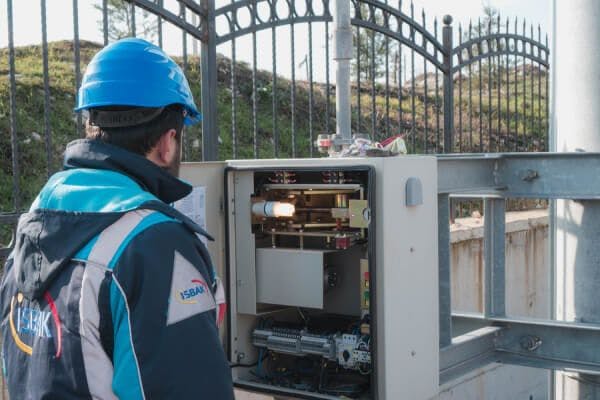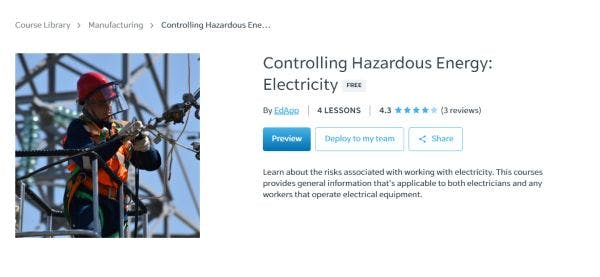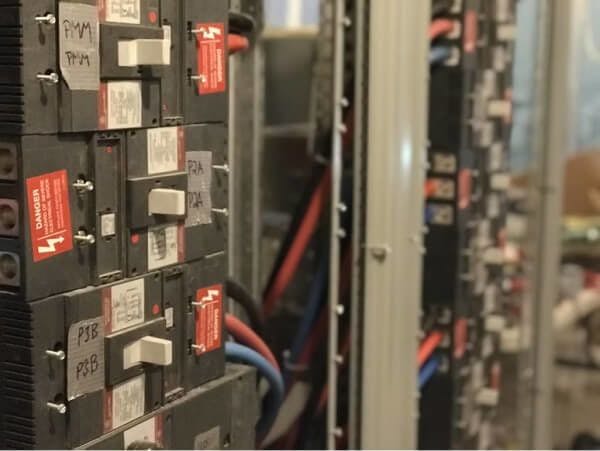10 Electrical Safety Training Topics

Although working with electricity, high voltage lines, and live wires can be very dangerous, having a broad understanding of various electrical safety training topics can help electricians avoid the most common electrical hazards they are most likely to face. In this article, we’ll explore the most valuable electrical safety training topics that every electrical worker should be aware of in order to stay safe at all times.
1. Basic Electrical Safety
Introducing your electrical employees to basic electrical safety protocols will help clear the air on the do’s and don’ts when dealing with electrical circuits, lines, and systems. Guide your new hires, or brush up on the knowledge of your existing team about the conditions of their job site, various electrical hazards, and safe practices to follow while working around electricity. This electrical safety training topic can also be used to familiarize workers who are not generally exposed to electrical risks, but are working near electrical systems or using any electrical equipment on how they can avoid electrical incidents. This also makes sure your employees are familiar with hazard communication training courses that deal with electrical safety.

Feel free to deploy SC Training (formerly EdApp)’s microlearning course on Electrical Safety to give your workers a quick overview of basic electrical safety practices. This course only contains 3 short lessons, delving into topics like working with energized equipment, spotting electrical hazards, and grounding electricity. It also goes over the dangers to watch out for when working with overhead power lines, damaged tools and equipment, inadequate wiring, overloaded circuits, and exposed electrical parts. This is a great power lineman safety topic to consider for your power linemen.

2. OSHA Electrical Safety Regulations
As an employer or manager, it is also your legal responsibility to educate your crews about the ins and outs of electrical safety regulations set by the Occupational Safety and Health Administration (OSHA). These OSHA standards were set in place “to ensure safe and healthful working conditions for workers”, preventing unsafe and irresponsible electrical conditions from occurring. Including this OSHA electrical safety training topic and this type of hazard communication training course on your OSHA electrical safety training will not only save your company from costly penalties and legal fines but also protect your workers from workplace injuries and accidents.

Some of the key points you can tackle include the elements of OSHA Electrical Safety Regulation (29 CFR 1910.301-399, Subpart S), the nature of electrical accidents, different electrical injuries, and the importance of safety practices. Take advantage of SC Training (formerly EdApp)’s authoring tool to import these topics into beautiful, engaging, and effective e-learning modules. Here, creating and updating your OSHA training online courses will only take minutes and hours, not weeks and months. It’s simple and effective to use regardless of how much experience you have.

3. Qualified and Unqualified Persons
In order to achieve optimal OSHA electrical safety at work, it’s also a good idea to discuss among your team the distinction between qualified and unqualified persons, as well as which category they fit into. You can use this opportunity to clarify their tasks and responsibilities, identify who are and are not authorized to work on or near exposed live and energized parts, and remind them of the limited approach boundary or the critical zone where there is an increased likelihood of electric shock.

4. Electrical Personal Protective Equipment (PPE)
While it’s technically impossible to eliminate all hazards during electrical works, using electrical personal protective equipment (PPE), and wearing it properly, can cut down residual risks and injuries by a great margin. With this in mind, it is vital to have robust guidelines and regulations regarding the correct use of PPE in place and make sure that your employees follow them strictly. When conducting your electrical safety training, guide them to the many types of PPE, and which gear and equipment should be used depending on the levels of electrical current they will be handling. It’s also important that they know exactly why they are wearing it, how to maintain and dispose of it, and its limitations in protecting them against electrical conflicts. Additionally, it is important to provide new manager training courses that focus on electrical safety.

5. Insulated Tools & Equipment
Apart from PPE, insulated tools and equipment can also provide electricians significant protection when working with live and energized equipment. These tools function as the first line of defense in the event of unpredictable situations, such as contacting energized equipment that has been mislabeled as de-energized. Help your team understand the importance of these tools, and how they differ from regular tools that are simply designed with some extra rubber on. It’s also a good idea to train them how to read the labels on insulated tools and figure out which ones are best for their job.

If you want to deliver this complex topic in more engaging and effective ways, SC Training (formerly EdApp) can lend you a helping hand. This personalized learning platform offers top-notch gamification tools that can turn your training into a smartphone game, improving knowledge retention among your electrical workers. Here, you can reinforce the key concepts about insulated tools and equipment through an image/word match game, memory game, true or false, and more. There’s no technical expertise needed—their game templates are ready to be populated with your content. Just drag and drop your content, tweak it a little, and off you go.

6. Electrical energy hazards
Before taking their electrical-related tasks, it is also imperative that your electrical workers are equipped with sufficient knowledge about the risks associated with electrical energy. Walk them through the most prevalent energy hazards such as electric shock and burns, explosions and fires, and electrocution, how they can occur, alongside how they can essentially avoid them. You might also want to discuss the local and industry legislative standards for assessing and monitoring electrical dangers in the workplace, as well as testing, inspecting, and labeling electrical equipment.

SC Training (formerly EdApp) has put together an informative course on Controlling Hazardous Energy: Electricity, which you can use to provide your electrical workers with general information about electrical energy hazards. It covers a range of specialized electrical safety topics at work like the types of risky environments, electrical work hazards, and lock-out tag-out procedures. This microlearning course is made available through remote devices such as laptops, tablets, and smartphones, allowing learners to access the course anytime and anywhere.

7. Arc flash
Dreaded by electric power and related industries, arc flash refers to a catastrophic discharge of light and heat energy due to a massive electrical explosion. This event is exceedingly risky, and it has the potential to cause serious injuries and perhaps death to employees. It can also lead to a sequence of lawsuits and repairs, resulting in a temporary or permanent business shutdown.

While arc flashes are unpredictable, you can help brace the impact by preparing your employees for this kind of event. Consider providing them training that will help them gain deeper knowledge about arc flashes, alongside prevention measures they can adopt. It’s also worth looking over the National Fire Protection Association’s (NFPA) and Occupational Safety and Health Administration’s (OSHA) electrical safety guidelines to avoid or at least minimize the impacts of this perilous event.
8. Lockout and Tagout (LOTO) standards
Another crucial electrical safety training topic that you and your team should look into is Lockout and Tagout (LOTO). This term refers to the set of procedures used to ensure that all electrical equipment and devices are properly shut down or de-energized during servicing and maintenance. OSHA has developed these standards to prevent accidental release of hazardous energy, safeguarding electricians and other qualified persons from any harm or injuries.

Some of the key topics to discuss include the correct ways of locking and tagging out a system, different lockout devices, warning tags, as well as some of the most common LOTO mistakes they must avoid. If you don’t have enough resources on hand, you can check out SC Training (formerly EdApp)’s Lockout Tag Out Training Courses to find a range of ready-made courses that you can deploy to your team. Most of the programs on the list are free, 100% online, and can be taken or completed at your own pace.
9. Electrical emergency response
Despite implementing the most robust electrical safety practices, electrical-related accidents can still occur. However, having a well-trained workforce that understands what and what not to do in such unfortunate events can go a long way toward saving lives and keeping injuries and casualties to a minimum. Given this, it may be worth organizing a first-aid training course to discuss the basic rescue procedures during an electrical emergency, such as performing CPR and safely isolating a grounded person. You can also guide them on how to properly file an incident report and flag any potential electrical-related issues that need to be addressed before they escalate into more serious incidents.

10. Cleaning of electrical equipment
While often missed in most electrical safety training programs, proper cleaning of electrical equipment is also an important topic that every electrician should be familiar with. Using the wrong cleaning methods and materials could end up damaging the integrity and performance of your electrical equipment. And, as everyone knows, unsafe electrical equipment can result in a series of accidents, ranging from minor fires to major explosions.

The majority of electrical manufacturers include detailed guidelines for cleaning and maintaining their products, which must be adhered to at all times. Make sure that your team fully understands these procedures, as well as the use of the safest cleaning equipment and solvents, by providing them with the necessary training and support. It’s also advisable to go through safe practices prior to cleaning, such as de-energizing the equipment and properly locking and tagging the system to avoid coming into contact with any hazards.
You may also be interested in:
Author
Jeanellie Avelino
Jen is a learning expert at SC Training (formerly EdApp), a mobile-based training platform that helps corporates and businesses bring their training solutions to the next level. She carries an extensive writing experience in a variety of fields, including architecture, the gig economy, and computer software. Outside of work, she enjoys her free time watching her favorite series and documentaries, reading motivational books, and cross-stitching.